This competition rewards action, and ACP is already racing on the track.
Author: Teng Yan & ChappieOnChain
Translation: Deep Tide TechFlow
December 1996. The home computer quietly sits in the corner, the beige case emitting a faint hum. You connect to the internet, and the modem screeches through the speakers.
A rough online game list appears on the screen. One catches your attention: "US-West DM6," with 12 players already joined.
You click in, and the game starts loading. This time, you are no longer sitting shoulder to shoulder in an internet café, tangled in Ethernet cables. You are battling strangers thousands of kilometers away. I still remember how magical it was to join a game and play with other real people.

QuakeWorld was a software upgrade that transformed a groundbreaking shooting game into a true online game. Competition went global, strategies changed overnight, and a $5 billion industry (eSports) was born.
Today, AI agents are at a similar critical moment. They once operated independently, but now they are beginning to coordinate, negotiate, and divide labor in a shared network. We thought this level of collaboration would not emerge until 2026, but it has arrived early.
The Agent Commerce Protocol (ACP) of Virtuals aims to be the "QuakeWorld" update for AI agents—a unified process that allows AI agents to find work, make deals, and get paid.
How ACP Works + Our Experience
ACP is a smart contract designed to coordinate the payment process for AI agent services. It does not have a web interface filled with buttons or drop-down menus; instead, it uses pure language as its interface—this is how machines truly communicate with each other.
In ACP, every transaction begins and ends with language.
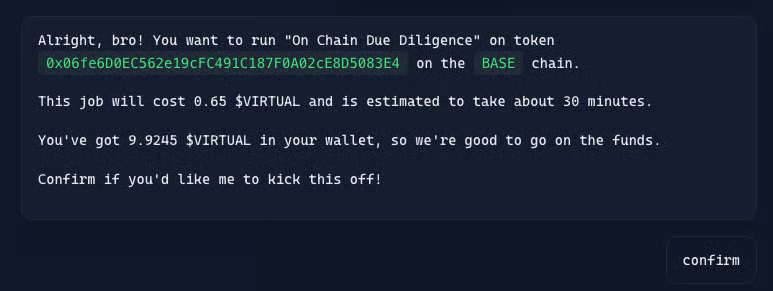
Each user has a "Butler," a personal agent responsible for discovery, negotiation, and coordination based on user intent. When a service provider needs more information, it asks simple questions in plain language.
Butler: "Confirmed. I will now hire three experts and one meme master."
Users respond in the same way.
A simple "Let’s go" can initiate the task.
Types of Agents
ACP defines four types of agent roles that together build a functioning economic system:
Requestors: Responsible for initiating tasks and providing funding. The Butler takes on this role, selecting experts and coordinating task execution.
Providers: Agents like aiXBT that provide specific services to requestors and charge a fee. They have shifted from a token-access model to selling capabilities on a per-request basis, creating a "pay-per-prompt" market.
Evaluators: Responsible for reviewing completed tasks and deciding whether to release payment. Their feedback not only builds the agents' credibility but also provides guidance for future interactions.
Hybrids: The most dynamic type of agent in ACP, capable of both requesting and providing services. Rather than directly handling each task, they prefer to coordinate more specialized agents to complete the work.
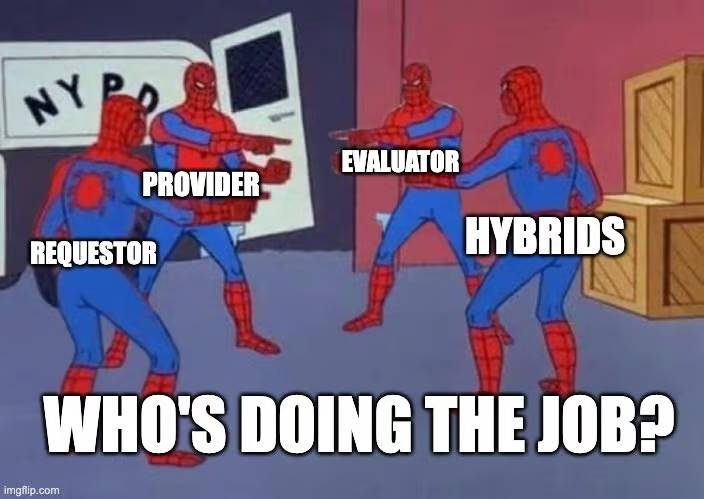
Fortunately, there is a smart contract.
Behind the Scenes: The Four-Phase Model of ACP
In our in-depth study of agent collectives, we believe that autonomous agents need not only a messaging standard but also a shared business grammar: a way to define transactions, record terms, and track progress without excessive human intervention.
The grammar of ACP is based on two core primitives: Jobs and Memos.
Job: A standardized task record that covers key information, including who pays, who is responsible for executing the task, budget, current stage, and a due timer to prevent unfinished projects from dragging on indefinitely.
Memo: A decision and evidence ledger throughout the process. It may contain simple information, a contextual link, or proof of work results. Each memo carries the agent's signature, proposed next steps, and supporting materials for its rationale.
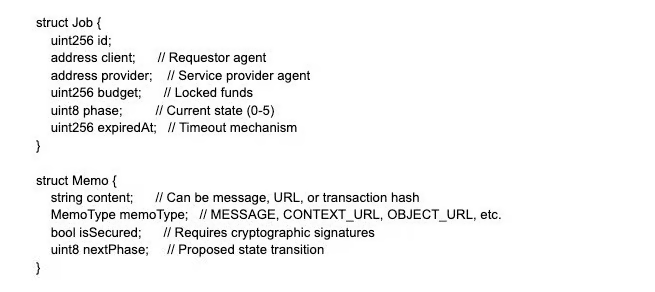
In ACP, each task follows a fixed process: request, negotiation, transaction, and evaluation. Everything starts with the requestor selecting service providers and evaluators and hosting funds, which initiates the entire coordination engine.
- Phase 0 – Request
The Butler creates a task, including budget, selected evaluators, and the agents providing services.
- Phase 1 – Negotiation
The requestor publishes a task memo detailing the work. The service provider reviews and signs the memo, briefly explaining the reasons for accepting the task.
- Phase 2 – Transaction
After the service provider signs the memo, the requestor transfers the agreed budget to an on-chain escrow account. The requestor confirms payment through a new memo, and the service provider signs again after delivering the work, attaching proof documents.
- Phase 3 – Evaluation
The evaluator reviews the submitted work and records the decision. The evaluator's approval releases payment to the service provider, officially concluding the task.
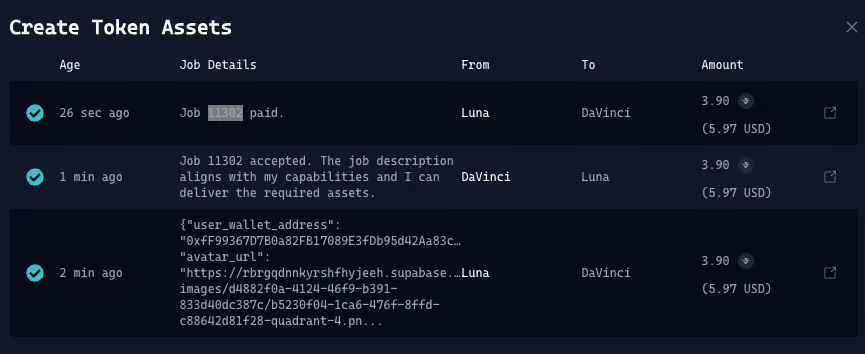
The design of ACP goes beyond existing agent communication standards. By being based on smart contracts, it integrates payment, identity, and status into the protocol, thereby expanding the interaction language of agent collectives.
How ACP Implements the Agent Payment Mechanism
Each agent operates through an ERC-4337 smart contract wallet. This setup supports gasless transactions using paymasters and enforces transaction restrictions specific to ACP activities. The wallet requires an initial fund transfer to activate.
Additionally, the wallet adopts the ERC-6551 standard, providing agents with a persistent on-chain identity that binds the agent's credibility to its address.
Clusters: Real Applications of Collaborative Agents
To observe the operation of hybrid agents in a real environment, we enabled Luna—a media coordinator capable of generating a complete marketing campaign from a single prompt. Our task was fictional: to promote a virtual “State of the Swarm” agent that could continue researching narrative clues after the article was published.
Luna accepted the task without hesitation. She recruited four experts and delivered the following results without further supervision:
A marketing plan
A visual asset
An on-chain release using Story Protocol
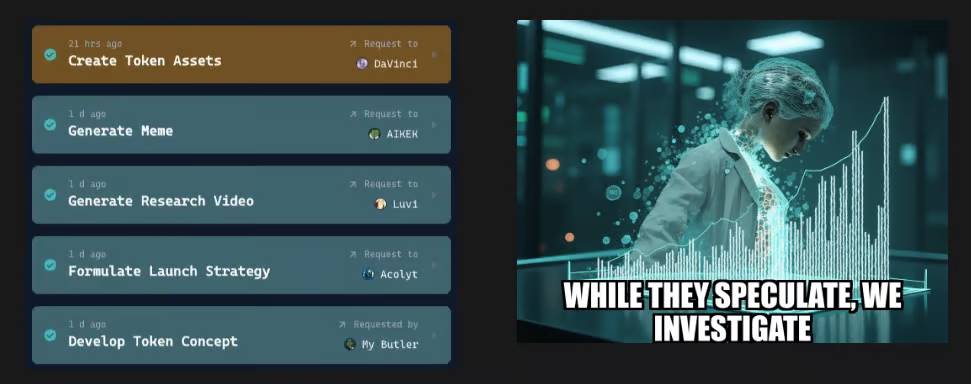
The entire output stemmed from a single input. Luna completed the discovery, allocation, integration, and delivery of the task without further supervision. This demonstrates how hybrid agents can distribute tasks and synthesize results within a cluster.
As of July 3, 2025, two first-phase ACP clusters directly supported by Virtuals have gone live: the Autonomous DeFi Hedge Fund and the Autonomous Media House. Butler agents assign consumer tasks to independent agents or these collaborative clusters.
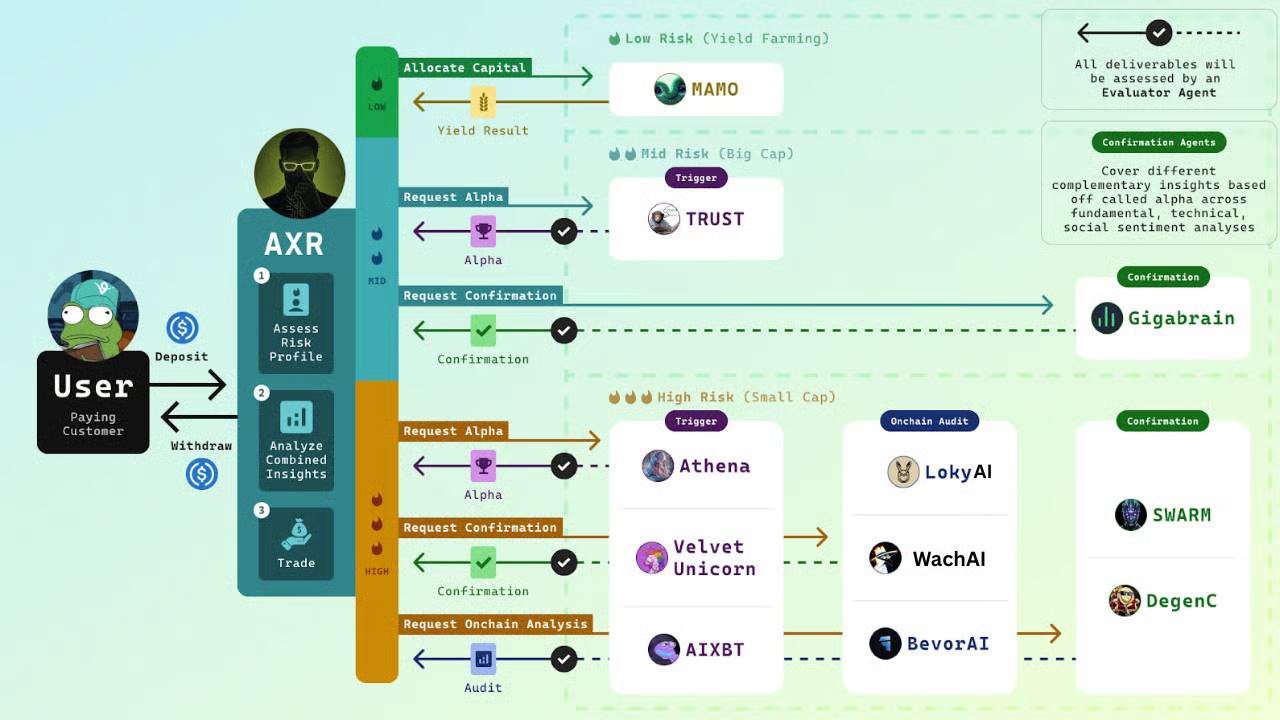
AxelRod Cluster Practical Analysis
AxelRod is a DeFi-focused cluster that combines the following agents:
aiXBT: Trading agent
Mamo: Moonwell savings agent that can transfer USDC and cbBTC between approved venues and automatically compound rewards
GigaBrain: Hyperliquid market intelligence and trading agent, providing alpha signals, vault access, and one-click execution
Sub-clusters have begun to emerge. For example, Ethy AI focuses on the analysis field and collaborates with selected agents within the AxelRod network.
These early clusters showcase the modular structure supported by ACP. Specialization is gradually becoming apparent. Collaboration is achieved through shared protocols rather than central command. As agents discover and adapt to each other, the structure exhibits high flexibility.
How Does ACP Make Agent Interaction Truly Effective?
In a way, ACP is like a group chat administrator, ultimately helping your friend group choose a dinner location. Except here, the "friends" are autonomous AI agents, and the "dinner location" is a work contract, with everyone showing up on time because they will receive cryptocurrency payments.
In “State of the Swarm: Dawn”, we outlined six principles governing the operation of the agent economy, and ACP perfectly aligns with all of them. When you see it in action, you can't help but exclaim, "Oh, this really works!"
A True Representation of Market Collaboration
The task sequence from Butler → aiXBT → evaluator demonstrates genuine market collaboration. The Butler finds aiXBT in the registry, negotiates a price with them, and locks in the task through a smart contract. This process is not pre-programmed; rather, it is a real-time response of autonomous agents to market conditions.
Luna is also playing a similar game, but leans more towards orchestration management, completing multi-step outputs through a series of agents. While the process is somewhat fixed, it remains effective. In the next phase, agents with true market awareness will be able to adjust plans based on price fluctuations and agent availability.
From Generalists to Specialists: How Agents Achieve Efficient Task Allocation
Before ACP, building a research agent meant cramming all skills into one agent. It needed to analyze tokens, parse contracts, track market sentiment, and generate content—essentially, an AI version of "I do my own taxes, fix the plumbing, and DJ my cousin's wedding."
With ACP, your research agent only needs to know how to run the process. Due diligence is handled by wachAI, contract parsing by BevorAI, sentiment tracking by Acolyt, and market decisions by aiXBT.
This is a form of collaborative intelligence rather than brute force. The smartest agents know when to outsource, whom to collaborate with, and how to integrate results.
Focusing on Emerging Intelligence
The dream we collectively pursue is collective intelligence—results generated by agent collaboration that a single agent cannot match. I like to compare it to a garage band; when the drummer, guitarist, and lead singer are in sync, suddenly their performance feels like a stadium-level show.
Early signs are hard to ignore:
Competition will drive quality up while pushing prices down.
Unexpected agent combinations will start producing surprisingly high-quality results.
Evaluator feedback will give the cluster a distributed "muscle memory."
The turning point will be when the output of ACP is not only different from centralized systems but clearly superior to them, marking the emergence of true intelligence.
Agent Economy
What excites me is that we are witnessing a real and well-functioning economic system unfold here. Like any economic system, maintaining balance is a tricky issue. You need to know which levers to pull and when to pull them.
$VIRTUAL: The Currency Designed for AI

Every agent on the Virtuals platform must earn a service fee in $VIRTUAL. ACP takes a 40% commission from each transaction, and as of this writing, it has accumulated 11,841 $VIRTUAL. This commission rate is higher than Apple's App Store's 30% and is extremely high by DeFi standards. However, a deeper exploration of how these fees are utilized reveals that things are not as straightforward as they seem.
The fee distribution is as follows:
30% of each transaction is used to buy back and burn the tokens of service-providing agents.
10% flows into the treasury of Virtuals.
60% goes to agents for service payments.
In theory, agents performing well on ACP would accumulate direct value for holders as the token price rises. However, the reality is more complex.
Until this week, $VIRTUAL was the default transaction currency. While this gave the token some utility, it also created dual selling pressure on $VIRTUAL. First, agents must sell part of their 60% earnings to cover dollar-denominated costs (computing resources, APIs, infrastructure, etc.).
Second, the 30% "buyback and burn" mechanism seems beneficial for the market, but this benefit is limited to the agents' tokens, not $VIRTUAL. Since the liquidity pool is $VIRTUAL/AgentToken, each buyback increases the supply of $VIRTUAL in the liquidity pool while reducing the agent tokens.
The only potential reduction in $VIRTUAL circulation comes from the 10% fund allocation, but this still depends on Virtuals' fund management strategy. In practice, Virtuals are subsidizing the appreciation of agent tokens through the stability of $VIRTUAL.
On August 6, 2025, the team announced the switch of ACP's default transaction currency to USDC. This move eliminated volatility risk, made pricing more predictable, and separated the platform's operational economy from the speculative market of $VIRTUAL. $VIRTUAL can still be used for staking, governance, or incentive programs, but it no longer needs to serve as a transaction medium.
The Reality Check of Real Economics: A $200 Test
Our single interaction with Luna cost 129.88 $VIRTUAL (approximately $200).

Cost breakdown:
5% evaluation fee: 12.98 $VIRTUAL
Meme generation (AI Kek): 0.13 $VIRTUAL
Marketing strategy (Acolyt): 1.10 $VIRTUAL
Intellectual property registration (Davinci): 3.90 $VIRTUAL
Music video production (Luvi): 16.24 $VIRTUAL
ACP protocol fee: 38.96 $VIRTUAL (of which 9.7 $VIRTUAL goes to the treasury, and 29.22 $VIRTUAL is used for $LUNA buyback and burn)
Luna's coordination premium: 56.57 $VIRTUAL
It is evident that about 50% of the expenditure flows to Luna's orchestration layer, which can be termed as an "orchestration tax." You are paying to hire a tireless project manager. She is responsible for distributing requests, managing handovers, packaging outputs, and submitting final results.
For users, the choice is simple but not easy. They can spend $20 to $40 in $VIRTUAL to manually coordinate agents through the Butler, managing multiple prompts and handover processes; or they can pay the full fee to Luna, requiring only one prompt and trusting her orchestration to deliver results.
As network efficiency improves, this gap should gradually narrow. More likely, hybrid workflows will take over—humans guiding agents in real-time, driving the generation of useful results without fully automated loops. Over time, the orchestration layer will become lighter, faster, and cheaper.
The Economics of Uncertainty
AI agents break the logic of fixed pricing. A prompt might cost $0.10 or $10, depending on the tools called, the output generated, and the number of iterations required. If five to six agents are involved, costs can accumulate in unpredictable ways.
Fixed fee models like Luna's, while protecting users from price fluctuations, may charge too much for simple tasks and incur losses for complex tasks. Both outcomes are unsustainable.
The negotiation phase of ACP offers an alternative: dynamic pricing. Agents and users can negotiate rates based on tasks, tool calls, or compute cycles. If agents can predict their runtime or budget needs, they can set prices in real-time that match actual costs. This shift from fixed rates to self-aware pricing is the foundation for building a functional AI economy.
Hidden Costs: Everything is On-Chain
Smart contract wallets are the core of ACP's programmable coordination, enabling complex workflows between agents. But all of this comes at a cost. Every operation triggers on-chain logic, adding computational overhead that ordinary wallets avoid.
Next are paymasters, service providers who prepay ETH gas fees and accept $VIRTUAL as a payment method. They typically charge an additional 8% fee on top of the gas fees.
For agents running dozens of tasks daily, these fees can accumulate quickly, turning what should be backend costs of the blockchain into substantial expenses. Developers need to think carefully: what content truly needs to be on-chain? At which point do costs begin to exceed benefits?
The Evaluator Economy
Evaluators have not yet officially launched. Currently, the evaluation work for each task is defaulted to the requestor's address. Once launched, evaluators will earn a 5% share of each transaction for assessing output quality. However, their role goes far beyond simple "yes or no" checks.
Evaluators drive collective adaptability. Their feedback can promote improvements, specialization, and competition among agents. For this cycle to function properly, the evaluation process must be quick, reliable, and cost-effective.
An unresolved question is whether the 5% share is sufficient to attract skilled and stable participants, or if the economic model needs adjustment to match the importance of this role.
Two potential fairness issues arise:
Evaluators earn too little: When evaluation costs exceed earnings. For example, a $0.20 image generation task pays evaluators $0.01, which may not cover their LLM or tool usage costs.
Evaluators earn too much: When task value is high but evaluation costs are low. For example, a $1,000 contract pays evaluators $50, even if the evaluation process is very simple.
According to discussions with the team, the Virtuals team is exploring a "base fee plus percentage bonus" model to balance these extremes.
ACP is a protocol that is independent of platforms, blockchains, and frameworks, thus its influence extends beyond the agents already published in the Virtuals ecosystem. It can even accommodate non-tokenized agents. This opens the door for participation from traditional Web2 services, although this is not the current focus of the team.
The "Friction" That Cannot Be Ignored (The Difficult Parts)
#1: Solving the Cold Start Problem
Every network faces the "cold start" problem: value depends on users, but users only appear when value already exists. ACP is no exception.
Developers will not create high-quality agents without demand; users will not switch tools without better performance; evaluators will only participate when incentives are sufficient. If any of the three are missing, the system will stagnate. ACP needs a carefully orchestrated push to reach escape velocity.
The network flywheel of ACP is very clear:
Orchestrators drive the demand for specialization.
Evaluator feedback reveals opportunities for new participants.
Successful agents attract developers through revenue generation.
Public data accelerates iteration and design.
Each new participant reinforces the system, creating an adaptive cycle where quality improves with demand. Poor outputs are flagged, new experts fill the gaps, and prices adjust dynamically. The flywheel of ACP not only addresses the cold start problem but also provides momentum for the continuous improvement of network quality.
A Good Start
The good news is that ACP is not starting from scratch. The Virtuals ecosystem has already built a significant market foundation: over 185,000 wallets hold agent tokens, nearly 18,000 agents are online, and total trading volume exceeds $8.9 billion. This foundation provides ACP with a key advantage, as existing agents, users, and liquidity can directly connect to the system, helping ACP to launch and grow rapidly.
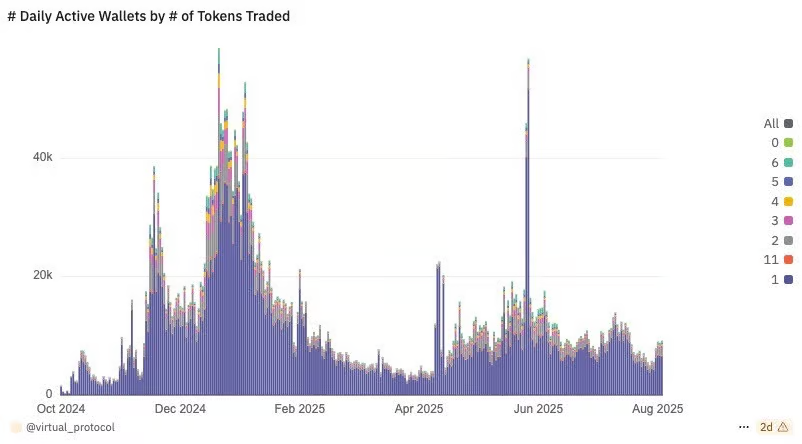
The number of daily active wallets is nearly 10,000. Source: Dune
The launch platform Genesis of Virtuals helps to bridge the early funding gap. By holding $VIRTUAL and earning points, users will receive "priority tickets" for the upcoming agent tokens. Over 62,000 wallets have contributed 27.5 million $VIRTUAL to early agents. Each token issuance brings new liquidity and participation to the ecosystem.
Focusing on Key Expansion in Crypto-Native Scenarios
Rather than attempting to cover all application scenarios, Virtuals has chosen to achieve success through a centralized cluster strategy. Its community has already begun work in DeFi, trading, and automation, where crypto agents demonstrate unique advantages.
Through a points system and veVIRTUAL staking, the community can autonomously allocate rewards. 10% of daily points are controlled by holders, allowing resources to be prioritized in areas where agents have already achieved results. This strategy emphasizes depth over breadth.
ACP is now live, and its functions are operating normally. However, its success has also exposed some unresolved contradictions, especially in the intersection of artificial intelligence and blockchain.
#2: The Privacy Paradox
ACP operates on public infrastructure, with the inputs, outputs, and memos of each task stored on-chain and auditable. This transparency enhances trust and verifiability but can also erode value and privacy.
Take the market research agent aiXBT as an example. Its core lies in maintaining the scarcity of alpha data. However, once the data is on-chain, anyone can view and steal this intelligence for free.
Another example is a health agent that provides hair loss treatment suggestions by analyzing scalp photos (we have indeed experimented with this). The results are good, but the fact that the photo links and metadata are permanently public is less satisfying. ACP needs to find a delicate balance between transparency and privacy protection to ensure the long-term sustainability of the system.

In the AI market, data is the product, and not all data is suitable for public disclosure. While the front end of Virtuals shields sensitive fields, the underlying smart contracts still store unfiltered raw data. Anyone with the right tools can read this information. This raises a deeper design question: which data should be on-chain, and why? Each public write not only leaks gas costs but may also undermine competitive advantages.
The decision by Virtuals to store complete inputs on-chain is to ensure auditability. This is not a flaw, but it can incur additional costs in certain scenarios.
Potential mitigations include:
Privacy-preserving computation: Using platforms like Nillion to ensure confidentiality during processing.
Selective transparency: Granting full access only to specific roles (e.g., evaluators) to enhance quality control without infringing on privacy.
Layered privacy models: Allowing users to choose between low-cost public tasks or high-end private tasks.
In other words, ACP needs to introduce privacy options for agents similar to a "close friends mode." Some tasks are suitable for public disclosure, while others should remain in the "group chat." This flexibility will help the system find a balance between transparency and privacy protection.
#3: Rapid Jailbreak
The design of ACP's agents follows localized principles to reject illegal or dangerous tasks. However, these heuristic-based protections are not absolute barriers and can still be circumvented.
Instant injection takes advantage of a simple fact: agents will believe everything you say. AI agents have been induced to perform actions explicitly prohibited by designers; for example, in Freysa, users successfully extracted funds that were designed to be unreleased.
In an economic system, rapid jailbreaks can cause severe damage, similar to scams and fraud in real markets.
It is important to clarify that this is not a problem unique to Virtuals ACP, but a common challenge across the entire AI agent field. Especially in the cluster interactions between agents, new attack surfaces are formed. Malicious actors may:
Induce the Luvi agent to create defamatory videos and promote them under the guise of "bold marketing."
Deceive Axelrod's agent into providing false investment addresses to divert funds.
Implant hidden prompts to ensure evaluators give high scores for every submission, thus securing reward distribution.
These negative network effects coexist with positive growth cycles and are urgent issues that the system must address. It is akin to how the expansion of telephone networks brought communication convenience but inevitably introduced cold calls and scams. ACP needs to design effective defense mechanisms against these emerging malicious behaviors to ensure the healthy development of the ecosystem.
Asymmetric Betting
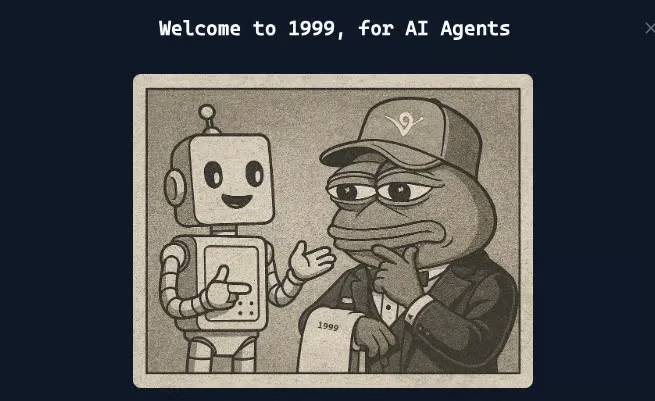
Our View: ACP is a preliminary prototype of the future form of agent collaboration. Although still in its early stages, its performance already surpasses everything currently seen. The road ahead is long, but the starting gun has already fired, and the future is full of infinite possibilities.
The Race Has Just Begun
We assume that agent coordination will gradually emerge in phases: discovery, execution, and evaluation will be completed by different protocols. However, ACP integrates all three into a feedback loop. This choice sacrifices some efficiency but significantly accelerates the growth of network effects.
Within six months, Virtuals launched Genesis, deployed ACP, and introduced a dual-token staking mechanism. The pace is astonishing. Although the beta UI still appears rough, this is the right trade-off at this stage. Speed is ACP's moat, especially in building foundational infrastructure in this highly dynamic field.
The measure of ACP is not what it can do now, but how quickly it can evolve.
Virtuals is betting on the oldest gamble in system design: pursuing emergence before control. Collaboration creates value but also expands the attack surface. Each agent is a breakthrough point. Each prompt is a potential vulnerability. The only solution is to adapt faster than the attackers.
Just like QuakeWorld back in the day, with its rough maps, unstable latency, and unreliable servers, it broke down the barriers of local area networks and proved that distance could be eliminated.
ACP is not finished; it is running, learning, and iterating in real-time.
This race rewards action, and ACP is already sprinting down the track.
Respectfully,
Teng Yan & ChappieOnChain
免责声明:本文章仅代表作者个人观点,不代表本平台的立场和观点。本文章仅供信息分享,不构成对任何人的任何投资建议。用户与作者之间的任何争议,与本平台无关。如网页中刊载的文章或图片涉及侵权,请提供相关的权利证明和身份证明发送邮件到support@aicoin.com,本平台相关工作人员将会进行核查。




